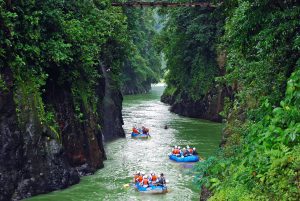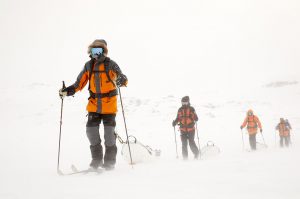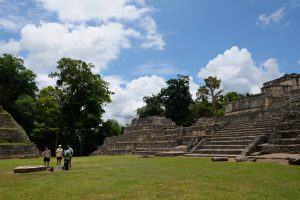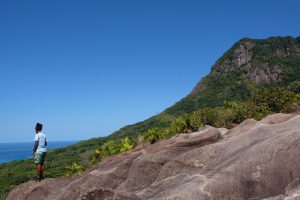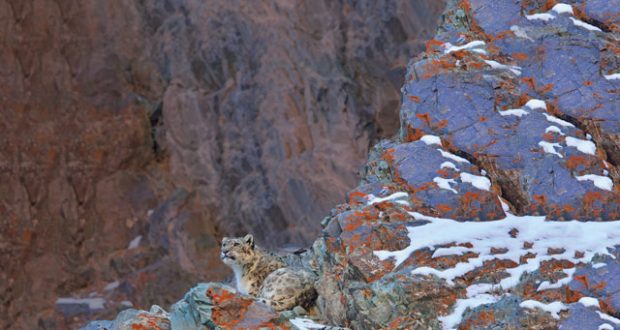
Meet the elusive snow leopards of northeast Ladakh — India’s resident wildlife is as varied as the vast subcontinent itself. Grab your binoculars and head out on a safari with a difference
View online at nationalgeographic.com
Om mani padme hum. This sacred Buddhist invocation of compassion is one I’ve often seen carved on prayer wheels or heard recited behind monastery walls. Now the words are being chanted for my protection and good fortune to the spirit, or la, of a high-altitude Himalayan pass — possibly under the gaze of nature’s most elusive and revered big cat.
While our group’s local guides murmur, unfurl strings of prayer flags and douse our impromptu roadside ceremony with fistfuls of incense, I squint up at the hillsides for signs of movement. A few hundred snow leopards prowl Ladakh’s plateaus, making the region a veritable haven for the species. But actually seeing a snow leopard, even when camping out in the wilds for a week with Naturetrek’s experts, is far from a given. We’ll need plenty of luck. Om mani padme hum, indeed.
Our small group of British travellers, together with the local spotters and our naturalist, Sujan, drives on through the broad, brown lunar landscapes of Hemis National Park until the road runs out. Here, our camp has already been set up for us: a circle of bell tents beside a frozen river, plus two canvas pavilions — one for cooking; one for dining. A shaggy domestic yak owned by a nearby village loiters expectantly, hoping for scraps.
“Denzel!” Sujan calls out, recognising the animal from last year’s trip. “Good to see you again.” We warm up with campfire-brewed chai as our guide cautions us against running off to explore the valley. “Today we rest. You’re not used to being at over 14,000ft and it would be inconvenient to have to evacuate you if you got acute mountain sickness,” Sujan jokes darkly. “We take it slowwwwly. Like a yak. Plod. Plod…” He pauses. “Plodddd.”
From where we’re camped, there’s plenty to spot. Golden eagles, griffons and vultures sail across the cloudless sky; snow cocks scutter through stubbly bracken, and pikas (a rabbit-like mammal) play hide and seek among the boulders of the river banks. The highlight of the afternoon comes when one spotter, Thamchoss, spies some stocky, thick-horned blue sheep — the favourite meal of the snow leopard. We train our binoculars and spotting scopes on the herd and wish them ill.
The next morning, I’m woken up by a commotion: voices; the rasp of opening tent zips; more voices. Lying in the centre of our camp, hooves akimbo, is Denzel. “This is an ex yak,” Sujan pronounces gravely. “Did a leopard get him?” I gasp. “I wish,” he scoffs, pointing out the trail of half-chomped carrots leading back to the collapsed kitchen tent. “It seems like Denzel’s midnight feast went awry.”
We don’t have long to mourn; a passing goat herder brings news of a sighting near Rumbak village. Temples throbbing and lungs heaving, we reach the outskirts of the village by mid-morning and set up our tripods to scan the landscape. Our spotter Dorje sees it first: “Duk! Duk! Shan!” he exclaims. I’ve got it! Snow leopard! He’s seen a head briefly peeking out from behind a rock. It’s an astonishing achievement, like finding a needle in a haystack — except the needle is also perfectly camouflaged. We point our scopes at the rock and wait for it to return. Eventually, our leopard emerges and stalks across the slope. There’s raw power in its gait, the promise of terrifying speeds in its muscular flanks and large paws. Its tail is surprisingly long, thick to the tip; its jaw is square; its eyes dark, wide-set almonds. Its famous pelage — the pelt leopards are still poached for — is pale and clouded by dark rosettes. When it finally takes its leave, it moves agilely along the ridge of the valley and then is gone. We look round at each other in awe. Did that really happen?
Spirits are high and the pressure is off for the rest of the week. We hike into different valleys each day to look for leopards and, along the way, discover incredible artifacts: stupas strung with diaphanous prayer flags; ancient petroglyphs carved into rocks lit with fire-coloured lichens; and fossils dating back 50 million years to the creation of the Himalayas. It’s all spectacular but, like the snow leopard, vulnerable: the region is on the front line of climate change, with rising temperatures across the mountain range threatening its ancient cultures and wildlife.
Towards the end of the week, I pass my most memorable birthday to date tracking the pugmarks of leopards and wolves, and fall asleep with a belly full of yak stew. “Denzel was a wonderful yak, inside and out,” Sujan had joked, making us all squirm. The cooks had even managed to procure a cake for me, and I had only one wish.
It comes true the very next day — our penultimate in the park — just as the sun is setting, crowning the distant peaks with shimmering halos. The group is silent, each of us soaking in the scenery or casually scanning the craggy valley, when Dorje, with his eye glued to his scope, starts shouting.
“Duk! Duk! Duk!”
ESSENTIALS
Naturetrek’s 14-day Ladakh: A Snow Leopard Quest costs from £2,995 per person (based on two sharing) including direct British Airways flights from London to Delhi, transfers, accommodation, all meals (except lunches and dinners in Delhi) and the services of a naturalist. Departs 14 February 2019.
Published in the October 2018 cover story of National Geographic Traveller (UK)





